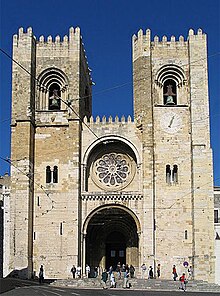Archbishop of Lisbon
|
Patriarchate of Lisbon Patriarchatus Ulixbonensis Patriarcado de Lisboa |
|
|---|---|

|
|
| Location | |
| Country | Portugal |
| Statistics | |
| Area | 3,735 km2 (1,442 sq mi) |
| Population - Total - Catholics |
(as of 2015) 1,924,650 1,648,885 (85.7%) |
| Parishes | 284 |
| Information | |
| Denomination | Roman Catholic |
| Rite | Roman Rite |
| Established | 4th century |
| Cathedral | Lisbon Cathedral |
| Current leadership | |
| Pope | Francis |
| Patriarch | Manuel III |
| Suffragans |
Angra Funchal Guarda Leiria-Fátima Portalegre-Castelo Branco Santarém Setúbal |
| Auxiliary Bishops | D. Nuno Brás da Silva Martins D. Joaquim Augusto da Silva Mendes D. José Augusto Traquina Maria |
| Map | |
|
The Archdiocese of Lisbon shown in a darker blue. |
|
| Website | |
| http://www.patriarcado-lisboa.pt | |
The Patriarchate of Lisbon (Latin: Patriarchatus Ulixbonensis) is an Archdiocese of the Roman Rite of the Roman Catholic Church based in Lisbon, Portugal. The diocese is said to have existed since the first century, but historical evidence shows its existence only since the 4th century.
The diocese of Lisbon was created in the 4th century, but it lay vacant after 716 when the city was captured by the Moors, notwithstanding that there are references to Mozarabic bishops of the Mozarabic Rite in that period. The diocese was restored when the city was recaptured by Alfonso I of Portugal during the Second Crusade in 1147 during the siege of Lisbon. A crusader's account of that event refers to the local "elderly Bishop of the city" being slain "against all right and justice", by marauding Flemish and German crusaders, in direct defiance of the terms of the city's rendition.
As Portugal grew in political importance and colonial possessions the jurisdiction of the Metropolitan of Lisbon expanded; Stadel says in his Compendium geographiae ecclesiasticae universalis (1712) that Coimbra, Leiria, Portalegre, Elvas, Funchal, Angra, Congo, St. James of Cape Verde, São Tomé, and Baia of All Saints were suffragans of Lisbon. As a reward for its assistance against the Turks, Pope Clement XI in 1708 raised the Chapel of the Royal Palace to Collegiate rank and associated with it three parishes in the dioceses of Braganza and Lamego. Later, yielding to the request of King John V, he issued the Bull In Supremo Apostolatus Solio (22 October 1716) — known as the Golden Bull because the seal or bulla was affixed with gold instead of lead — giving the collegiate chapel cathedral rank, with metropolitical rights, and conferring on its titular the rank of patriarch.
...
Wikipedia
